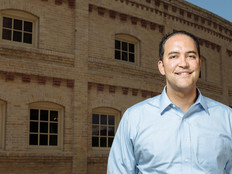Interior, VA and DOJ Chart the Way Forward on IT Reform
A new era for modernizing government IT could be at hand.
Earlier this month, the Senate passed the Modernizing Government Technology Act as part of the 2018 National Defense Authorization Act, sending the bill to President Donald Trump for his signature following passing in the House.
Yet agencies are still trying to figure out how they will respond to the MGT Act and its promise of working capital funds to modernize IT. To help them chart a course forward, the nonprofit Partnership for Public Service partnered with Accenture and released a blueprint earlier this month to spur improvements in federal technology management.
SIGN UP: Get more news from the FedTech newsletter in your inbox every two weeks!
The blueprint outlines five strategies agencies should undertake as they embark on IT modernization projects, based on interviews conducted over the past six months with current and former IT experts throughout government:
- Link technology initiatives directly to results, based on a deep understanding of the agency’s mission
- Transform the agency culture and how it does business
- Focus people and become adept at managing many different stakeholders
- Encourage agencies to act quickly and take risks
- Manage changes coming from new technology — don’t react
“I think the message here is the world is changing, agencies’ missions are changing and the technology that agencies are using to accomplish the mission are probably changing faster than all of this stuff,” Eric Keller, senior manager for research and evaluation at the Partnership for Public Service, said earlier this month at an event focused on the blueprint’s release, according to FedScoop.
“One of the theories we came into this work with was that new technology sometimes requires a new approach to leadership,” he said.
Transforming Government IT in Practice
The report shares tips and insights that Accenture and PPS captured from interviews with experts who have led technology transformations in government.
The idea is to give agency IT leaders a guide on what they need to know before they embark on IT reforms — where to start, which stakeholders need to be involved, and how to maintain momentum and achieve lasting benefits.
At the event in Washington earlier this month to discuss the blueprint, several agency IT leaders discussed how they have put the ideas behind the report into practice in digital transformation initiatives.
For example, acting Veterans Affairs Department CIO Scott Blackburn said that following the scandal over veterans’ wait times at agency hospitals, the VA needed to regain veterans’ trust, according to FedScoop. So, the agency focused on designing technology systems that both veterans and hospital staff could easily use.
“When we are doing this, we really need to ground ourselves in the end user and getting the entire management team focused on that goal,” he said. “Our transformation, like all others, it revolves around people, revolves around processes and revolves around technology. And all three of those play an incredible part, and I think people is the most important.”
Meanwhile, at the Interior Department, CIO Sylvia Burns said the agency got its senior leadership involved in discussions on how to comply with the Federal Information Technology Acquisition Reform Act. That committee allowed all relevant stakeholders inside and outside the CIO’s office to understand what they needed to do to comply and how they could work together to do so. That led to a unified approach, Burns told FedScoop.
“Quite honestly, through that process, I feel like we got strong,” she said. “It started with [the belief] that we have to be together in the department first. If we are going to face the bureaus and ask them to do this, we can’t not have our act together.”
Even as agencies adopt new technologies, they need to keep focused on how IT helps them achieve their mission, Justice Department CIO Joseph Klimavicz said to FedScoop.
“My thinking is that the missions really don’t change when we change administrations,” he said. “As we move through, priorities shift and you need to be sensitive to that. If you want to get funding for your projects, you need to know where the priorities are. But the mission doesn’t really change.
“It’s great to be a change agent, but if you don’t keep the lights on or your core customers happy, you don’t get to be a change agent. You have to be really good at the basics to be able to focus on change,” Klimavicz added.









